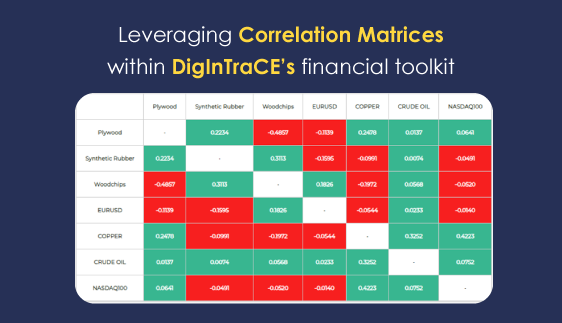One of the goals of the DigInTraCE project (EU-funded Horizon Europe project - Grant Agreement No. 101091801) is to revolutionise decision-making and risk management in the secondary raw materials market by integrating advanced financial analysis tools, with a particular focus on accurate and reliable FX pair predictions. As the demand for sustainable practices and circular economy solutions grows, the secondary raw materials market — encompassing recycled metals, plastics, wood, paper, and other reusable commodities — is becoming increasingly globalised.
To address these challenges, DigInTraCE’s financial toolkit, developed by Hypertech, leverages cutting-edge AI-driven models and decision-making mechanisms that provide precise FX rate predictions. By offering insights into potential currency movements, the toolkit empowers businesses to better manage exposure to currency risk, which can significantly affect the cost structure of international transactions involving secondary raw materials. Moreover, DigInTraCE’s financial toolkit capabilities enable stakeholders to optimise their pricing strategies by anticipating FX rate changes that might impact their competitive positioning in different markets. This strategic advantage is particularly valuable in an industry where even minor fluctuations in currency values can have profound impacts on profitability, especially for companies operating with narrow margins.
By integrating these sophisticated predictive capabilities, DigInTraCE provides a robust framework for navigating the intricate web of international markets. It enables companies to not only survive but thrive in an increasingly interconnected and competitive environment. As the secondary raw materials market continues to expand and evolve in response to global sustainability challenges, DigInTraCE ensures that its users are well-equipped to adapt to these changes, promoting both more sustainable practices and more profitable outcomes in the long term. In the following section we analyse why reliable fx pair predictions are important in secondary raw materials markets, the role of FX rates and how reliable predictions can be of help to market participants.
The Importance of Reliable FX Pair Predictions in the Secondary Raw Materials Markets
The secondary raw materials market, which includes recycled metals, plastics, wood, paper, and other reusable commodities, is increasingly vital for global industries striving for sustainability and cost efficiency. These materials are a cornerstone of the circular economy, helping to reduce waste, lower greenhouse gas emissions, and diminish reliance on finite primary resources. As environmental regulations tighten and corporate sustainability commitments grow, the demand for secondary raw materials is expected to rise significantly. To navigate this evolving landscape, understanding the myriad factors that influence market dynamics, such as supply and demand shifts, technological advancements, and geopolitical influences, becomes essential for market participants.
One of the most significant yet often overlooked influences on the pricing and trade of secondary raw materials is foreign exchange (FX) rates. Given that the secondary raw materials market is inherently global, with significant trade flows across international borders, FX rates directly impact the competitiveness and profitability of transactions. For example, the cost of importing recycled metals from Europe to the United States can fluctuate dramatically based on the EUR/USD exchange rate. Similarly, when exporting recycled plastics to Asian markets, shifts in the USD/JPY pair can alter the financial outcomes of these trades.
In addition to affecting direct trade costs, FX rates influence broader market dynamics by impacting the cost structures of businesses involved in processing, distributing, or utilising secondary raw materials. For instance, companies that rely heavily on imported recycled feedstock face exposure to currency risk, which can affect their margins if not properly managed. Moreover, fluctuations in FX rates can alter the relative attractiveness of secondary raw materials compared to their primary counterparts, influencing demand patterns. For example, if the dollar strengthens, commodities priced in USD, including primary metals, may become more expensive for foreign buyers, potentially boosting the demand for cheaper, locally sourced recycled alternatives.
The Role of FX Rates in Secondary Raw Materials Markets
FX rates play a crucial role in the pricing and trade of secondary raw materials, as many transactions in this market occur internationally. Fluctuations in currency values can significantly affect the cost of importing or exporting secondary raw materials, impacting profitability for companies involved in these transactions. For instance, a strengthening US dollar against the euro can make exports from the US more expensive for European buyers, potentially reducing demand. Conversely, a weaker dollar can make US secondary raw materials more attractive internationally, boosting export opportunities.
In addition, many secondary raw materials are priced in global benchmarks, such as the US dollar. This pricing structure means that any change in the dollar's value directly affects the local currency price of these materials in markets worldwide. For example, if a recycler in Europe purchases recycled aluminum priced in dollars, a weakening of the euro against the dollar would increase the cost in euros, impacting profit margins and overall market demand.
Why Reliable FX Predictions Matter
Cost Management and Pricing Strategies: For companies involved in buying and selling secondary raw materials internationally, FX rates can significantly affect operational costs. Reliable predictions of FX pairs enable these companies to better manage costs associated with currency fluctuations. For example, a company expecting a depreciation in its local currency relative to the dollar might pre-emptively lock in current rates through hedging instruments, such as forward contracts or options, thereby protecting itself against adverse movements.
Investment Decision-Making: Investors in secondary raw materials markets use FX predictions to make more informed decisions. By understanding potential currency movements, investors can assess the attractiveness of investing in foreign-denominated assets or companies. For instance, if an investor expects the Japanese yen to strengthen against the US dollar, they might prefer investments in Japanese companies dealing with secondary raw materials, as these investments could offer additional returns from currency appreciation.
Market Demand Forecasting: Predicting FX rates can also help businesses forecast demand in different markets. A company that correctly anticipates a strong dollar might expect lower demand from foreign buyers, leading to strategic decisions such as increasing focus on domestic markets or adjusting inventory levels. Conversely, a forecast of a weaker dollar might signal opportunities to ramp up exports.
Competitive Positioning: FX predictions can offer a competitive edge by allowing companies to price their products more competitively in foreign markets. For example, a company that anticipates currency depreciation might choose to price aggressively in international tenders, knowing that future profits will benefit from favourable currency movements. This approach can help capture market share and establish stronger relationships with foreign buyers.
Hedging and Risk Management: Accurate FX forecasts are crucial for effective hedging strategies. Companies dealing with secondary raw materials can use these predictions to mitigate risks associated with adverse currency movements. By implementing hedging strategies based on reliable FX forecasts, companies can stabilize their cash flows and reduce the uncertainty associated with fluctuating exchange rates. This stability is particularly important in industries with thin margins, where even small changes in FX rates can have significant financial impacts.
Building Reliable FX Predictions
Creating reliable FX predictions involves using a combination of historical data analysis, economic indicators, and advanced modelling techniques such as machine learning and econometrics. Key factors that influence FX rates include interest rate differentials, geopolitical events, trade balances, and market sentiment. For the secondary raw materials market, it’s also important to consider commodity-specific factors, such as demand and supply dynamics in primary markets, as these can indirectly impact FX rates through their effect on broader economic conditions.
Sophisticated models that integrate these factors can provide more accurate FX forecasts, enabling businesses and investors in the secondary raw materials market to make better-informed decisions. For example, machine learning models that account for non-linear relationships and interactions between different economic variables can offer enhanced predictive accuracy compared to traditional methods.
Conclusion
In the complex and interconnected world of secondary raw materials, the ability to accurately predict FX rates is a powerful tool for businesses and investors alike. Reliable FX predictions can help manage costs, optimize pricing strategies, make better investment decisions, and effectively hedge against risks. As global trade continues to expand and the secondary raw materials market grows, the importance of incorporating FX predictions into strategic planning will only increase. By leveraging advanced predictive tools and methods, stakeholders in this market can gain a significant advantage, positioning themselves to thrive in a dynamic and competitive environment.
Disclaimer: Views and opinions expressed are those of the author(s) only and do not necessarily reflect those of the European Union or HADEA. Neither the European Union nor the granting authority can be held responsible for them.






